It’s no secret how much we love squats here at PaleoHacks, but we’re a huge fan of lunges, too. This is because after squats, lunges are one of the most primal exercises that we, as humans, can do. Ready to learn how to do a perfect lunge?
The benefits of lunges are almost infinite. They strengthen all muscles throughout the legs, strengthen your core, improve your balance, mobility, and flexibility, and even help in muscle stabilization. They improve spacial and body awareness, and help stretch out tight hips.
However, there are still people out there that don’t like lunges and even those that believe lunges are bad for your knees—gasp! This, of course, couldn’t be farther from the truth—unless you have a knee injury, replacements, or arthritis.
Can you spare 10 minutes a day? Then you can do this 7-Day Paleo Weight Loss Bodyweight Workout Challenge!
Click here to get your FREE copy!
But for most of us, lunges are actually beneficial for keeping our knees healthy. Common lunge mistakes are almost always to blame for discomfort in the knees, and today we are going to go over some of the most common mistakes and how to fix them, so that you can perform pain-free and perfect lunge.
Common Mistakes and How to Fix Them
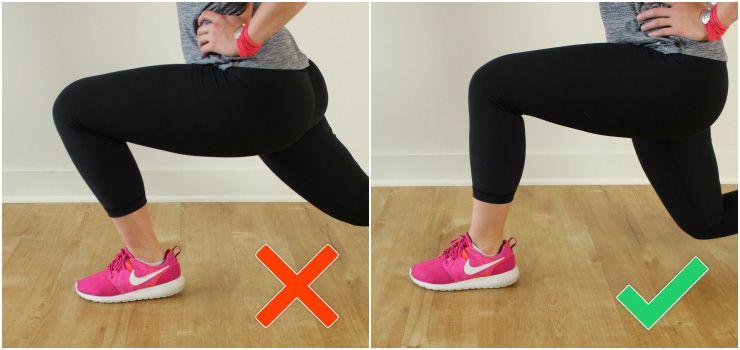
Weight in the Front Toes and Knee in Front of the Toes: Many people complain that lunges hurt their knees, but if you have no knee injuries, lunges should NOT hurt your knees when done correctly. The most common reason for pain in the knees is having too much weight in the front toes AND letting your front knee go too far over the toes. This will put stress in the tendons of the knee, causing pain and discomfort.
How to Correct It: When stepping into your perfect lunge position, place the weight in the front heel and keep the knee directly over the heel. To make sure sure the weight is in the heel, try wiggling your toes in the front foot.
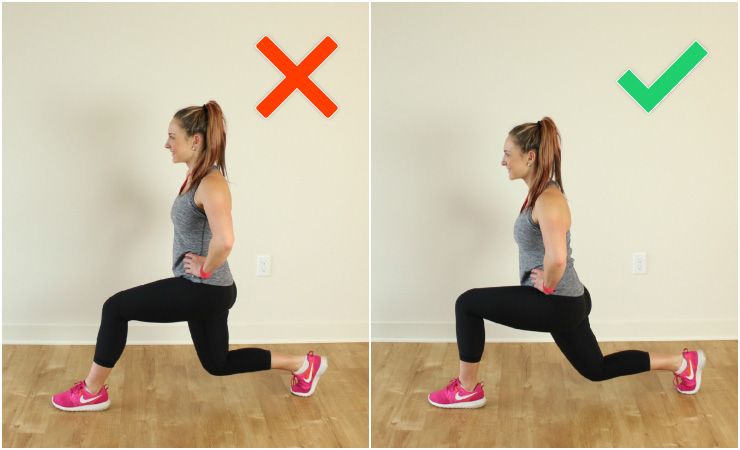
Too Much Weight in the Back Foot: Placing too much weight in the back leg can also lead to stress in the knees. This stance will also overwork the quadriceps, preventing the hamstrings and glutes from fully activating.
How to Correct It: Really focusing on keeping the weight in the front heel, as described above, will help keep your weight placement correct, but also practice your perfect lunge stance and try to only use the back leg for balance. You should be able to lift those back toes off the ground pretty easily when doing this, almost as if you were doing a single-leg squat.
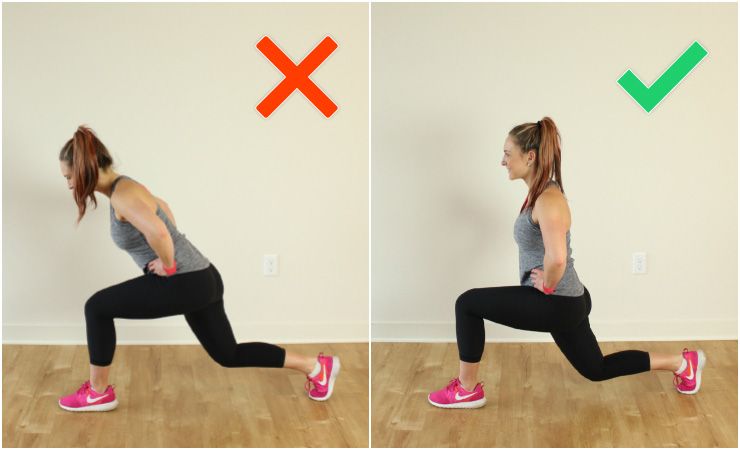
Leaning the Torso Forward: One of the greatest benefits of lunges is their ability to stretch the hip flexors in the back leg. Hinging your torso forward in your lunges doesn’t allow your hip flexor to fully extend. Leaning your torso may also be a sign of weak glutes. So focusing on strengthening your glutes may also help to keep the torso upright. Also, hinging the torso forward will put stress in the spine, especially if you add weight, such as a dumbbell across your shoulders.
How to Correct It: Make sure to properly warm up, foam and stretch before performing your lunges. Focus on stretching the hip flexors. You could even hold a stationary lunge position to stretch the hips before starting. This will allow the torso to stay more upright, protecting the spine.
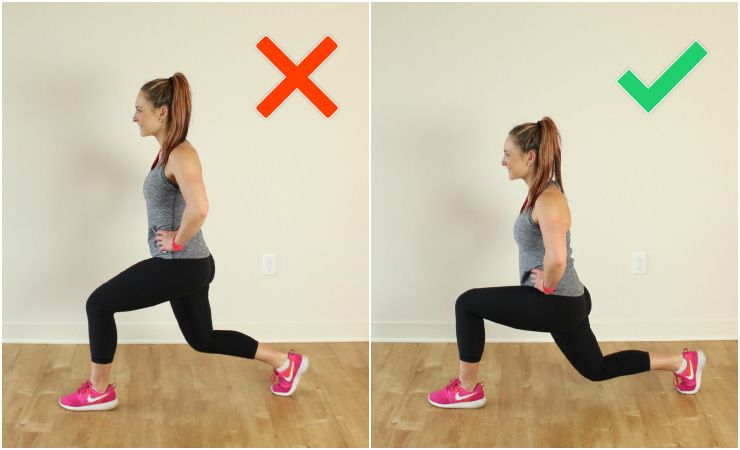
Not Going Low Enough: This mistake is made by many people when they first begin lunging. They don’t get deep enough into the lunge to engage the hamstrings and glutes.
How to Correct It: Aim to get your front knee bent to about 90 degrees, keeping the knee directly over the heel. The back knee should be just hovering an inch or so off the ground. Lowering to this depth will allow for maximum hamstring and glute contraction, and will properly stretch the hips.
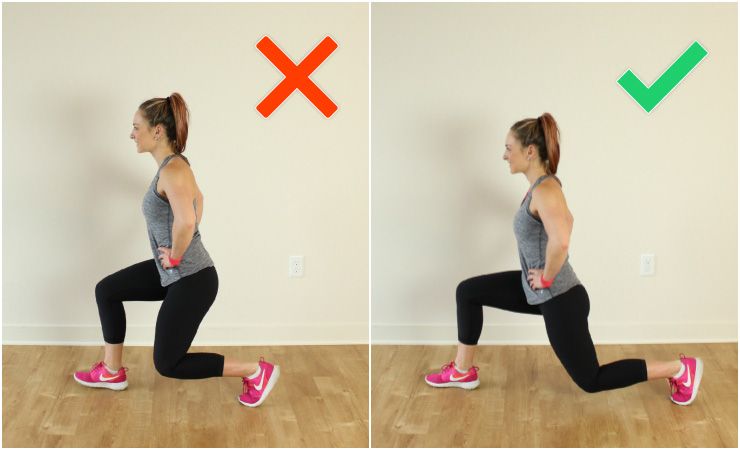
Your Stance is Too Narrow: Another common mistake for newbies is not taking wide enough steps in your lunges. This also puts unnecessary stress on the knees and tendons.
How to Correct It: To find the correct placement of the foot, you should do a stationary lunges in front of a mirror, to get a feeling of how far apart you need to step your feet. Both knees should have a 90-degree bend, and the back knee may even be extended a little farther back than that, with that knee hovering off the floor, as mentioned above. Once you feel comfortable knowing how far apart your feet need to be, try doing a few front or rear lunges, working on finding that correct stance.
Lunge Variations

Stationary Lunge
Begin with your feet together and take a big step behind you with your LEFT leg, keeping your LEFT heel off of the floor, and your weight in your RIGHT leg. Slowly bend both knees, lowering your body straight down until both knees are at 90-degree angles, and keeping your front knee over your heel.
Push down through your front heel as you stand back up, keeping your feet in the perfect lunge stance. Complete 10-20 repetitions, and then switch sides so that the LEFT foot is in front.
Front Lunge
Start by standing with feet together and your weight in your RIGHT leg. Step your LEFT foot forward, shifting your weight into your front heel. Your knees should be bent at about 90 degrees, and be sure to keep your torso upright.
Powering through your front heel, use your glutes and hamstrings to press back and up to standing. Complete 10-20 repetitions stepping the LEFT foot forward, and then switch sides.
Rear Lunge
This is very similar to the lunge above; however, this time you are stepping BACKWARDS instead. Start with feet together and your weight in your RIGHT leg. Step your LEFT foot back, keeping the weight in your front heel. Your knees should be bent at about 90 degrees, and be sure to keep your torso upright.
Power through your front heel, and use the glutes and hamstrings to press forward to stand. Complete 10-20 repetitions stepping the LEFT foot back, and then switch sides.
Walking Lunges
Making sure you have enough space (about a 15-foot hallway is enough), start with your feet together and hands on your hips or by your sides. Step your RIGHT foot forward far enough so that when you lunge down, your RIGHT thigh is parallel to the floor. You should feel a stretch through the front of your LEFT hip, in the hip flexor.
Press though your RIGHT heel and power up to bring your feet together, and stand up. Repeat, stepping the LEFT foot forward. Complete 10-15 reps, then turn around and lunge back to your starting point.
Lateral Lunges
This is a bit different than regular lunges, since one leg will actually be staying straight, but many of the core concepts will remain the same. Start by standing with feet together, then step your RIGHT foot to the RIGHT, slightly in front of you. Make sure to shift your weight into your RIGHT heel, sitting your hips back and making sure the knee doesn’t go in front of the toes.
You should feel a stretch in your left inner thigh and have barely any weight in that foot. Power through your right heel to engage your hamstrings and glutes as you step your feet back together. Complete 10-20 repetitions on one leg, then switch to the other side.
After correcting these mistakes, you should be on your way to doing the perfect lunge. You’ll have stronger legs in no time!
Tick Tock Lunges
For this move, you’ll be lunging forward and back. Start with a rear lunge and step your RIGHT foot back. Push off your RIGHT foot and without stopping, step forward into a front lunge. Repeat this 10-12 times, then switch legs.
Watch the Perfect Lunge Video Below!
(Your Next Workout: How to Do the Perfect Squat)


 Rustic Pumpkin Pie Pop Tarts
Rustic Pumpkin Pie Pop Tarts
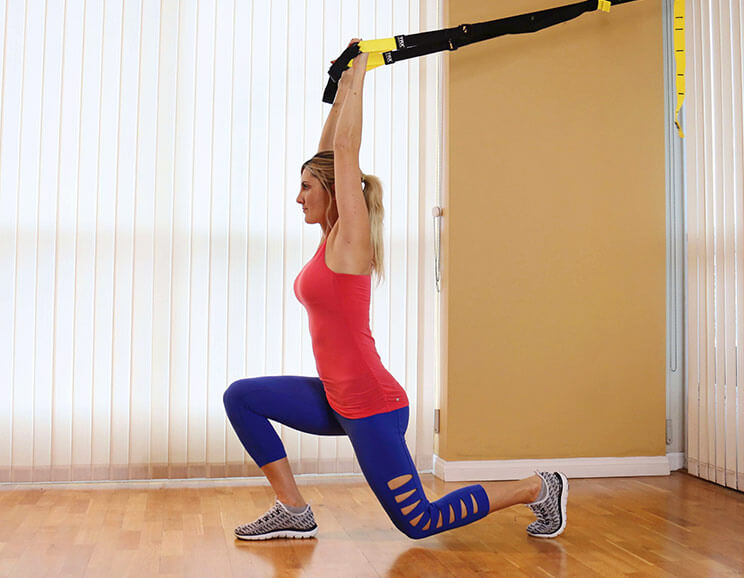
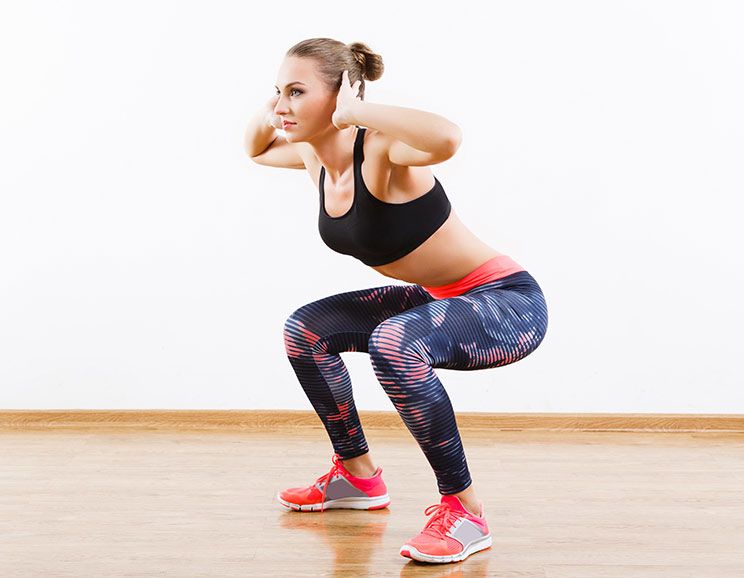





Show Comments